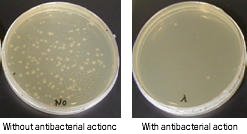Since trace amounts of metal ions of silver and tin not only have antibacterial action but also are human-friendly, silver plating for fiber products and tin plating for tableware now play an active part. Recently, electroless nickel-titanium oxide composite plating with photocatalytic titanium oxide particles dispersed in plating films and electroless nickel-Teflon composite plating having antifouling and washability features have been developed.
| Type of plating | Characteristic value | Uses | |
|---|---|---|---|
| Plating film (plating appearance) |
Number of bacteria surviving after 24-hour contacta (CFU a/9cm2) | Reduction rate of bacteriab/% | - Medical, nursing, and public facilities - Food manufacturing, biological peripheral devices - Silver tableware - Refrigerators, air-conditioners, and other home electrical appliances - Socks and other fiber clothing - Plumbing products for kitchens, bathrooms, toilets, etc., where bacteria and sliminess easily grow - Algae inhibitors |
| Cu (bright) | <50 | 100 | |
| Ag (semigloss) | <50 | 100 | |
| Zn (dull) | <50 | 100 | |
| Cr (dull) | 1.6×106 | 33.3 | |
| Ni (dull) | 2.5×105 | 89.6 | |
| Ni (semigloss) | 2.3×104 | 99.0 | |
| Ni (bright) | <50 | 100 | |
| Ni-9P alloy (bright) | <50 | 100 | |
| Co (dull) | <50 | 100 | |
| Sn (bright) | 1.1×106 | 54.2 | |
| Ni-P-PTEE (bright) | <50 | 100 | |
| Number of initial bacteria: 2.4×106 (CFU/9cm2) a CFU: Colony Forming Unit b Reduction rate of bacteria/% = (A-B) / A × 100 A … Number of initial bacteria B … Number of bacteria surviving after 24-hour contact |
|||

Escherichia coli culture examination
(zinc plating)